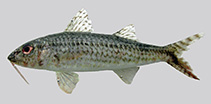Upload your photos and videos
Pictures | Google imageUpeneus willwhite
Picture by White, W.T.
Pictures | Google imageUpeneus willwhite
Picture by White, W.T.
Common names from other countries
Classification / Names Common names | Synonyms | Catalog of Fishes(genus, species) | ITIS | CoL | WoRMS | Cloffa
Teleostei (teleosts) > Mulliformes (Goatfishes) > Mullidae (Goatfishes)
Etymology: Upeneus: Greek, ypene, -es = upper lip (Ref. 45335); willwhite: Named for William T. White, Australian National Fish Collection, CSIRO National Research Collections Australia, Hobart, Australia.
Eponymy: Dr William Toby White (d: 1977) is an Australian ichthyologist whose particular interests are speciation and biodiversity of sharks and rays and fishery management in developing countries. [...] (Ref. 128868), visit book page.
Etymology: Upeneus: Greek, ypene, -es = upper lip (Ref. 45335); willwhite: Named for William T. White, Australian National Fish Collection, CSIRO National Research Collections Australia, Hobart, Australia.
Eponymy: Dr William Toby White (d: 1977) is an Australian ichthyologist whose particular interests are speciation and biodiversity of sharks and rays and fishery management in developing countries. [...] (Ref. 128868), visit book page.
Environment: milieu / climate zone / depth range / distribution range Ecology
Marine; demersal; depth range ? - 25 m (Ref. 123711). Tropical
Distribution Countries | FAO areas | Ecosystems | Occurrences | Point map | Introductions | Faunafri
Eastern Indian Ocean: Indonesia.
Size / Weight / Age
Short description Identification keys | Morphology | Morphometrics
Dorsal spines (total): 7; Dorsal soft rays (total): 9. This species is distinguished by the following characters: D VII + 9; pectoral fins 14; gill rakers 6 + 15-17 = 21-23; moderately elongated body is laterally slightly compressed. Measurements as % SL: body depth at first dorsal-fin origin 23-24 and at anal-fin origin 20-21; caudal-peduncle depth 9.6-9.9, width 4.2-4.3; maximum head depth 20-21; head depth through eye 16; head length 29; snout length 10-11; orbit length 7.1-7.5; upper-jaw length 12; barbel length 20; caudal-fin length 28-30; anal-fin height 16-17; pelvic-fin length 20-21; pectoral-fin length 19-20; first dorsal-fin height 20, with dorsal-fin spines proportionally decreasing in height; second dorsal-fin height 17; total oblique bars on caudal fin 11-14. Bod markings and colouration: upper caudal-fin lobe with 5-6 brown mostly straight bars while lower caudal-fin lobe with 6-8 short brown bars ventrally, connecting dorsally to a brown stripe of about orbit diameter in its maximum width, and with about 3 short red, brownish-ochre bars along dorsal margin that do not correspond with bars on ventral-lobe margin; caudal-fin stripe and bars retained even when preserved; dorsal fins in fresh fish with 3-4 thin brown stripes, also retained in preservative; when fresh barbels reddish white; body when freshly deceased is dark brown dorsally and pale brown ventrally, ventral margin white; mid-lateral body stripe dark brown, rather inconspicuous on snout and posterior half of body; head entirely grey brown; body and head dark brown dorsally and pale brown ventrally when preserved (Ref. 123711).
Life cycle and mating behavior Maturity | Reproduction | Spawning | Eggs | Fecundity | Larvae
Main reference
Upload your references | References | Coordinator : Randall, John E. | Collaborators
Uiblein, F. and H. Motomura, 2021. Three new goatfishes of the genus Upeneus from the Eastern Indian Ocean and Western Pacific, with an updated taxonomic account for U. itoui (Mullidae: Japonicus-species group). Zootaxa 4938(3):298-324. (Ref. 123711)
Threat to humans
Harmless
Human uses
FAO(Publication : search) | FishSource |
More information
Trophic ecology
Food items
Diet composition
Food consumption
Food rations
Predators
Food items
Diet composition
Food consumption
Food rations
Predators
Ecology
Ecology
Home ranges
Ecology
Home ranges
Population dynamics
Growth parameters
Max. ages / sizes
Length-weight rel.
Length-length rel.
Length-frequencies
Mass conversion
Recruitment
Abundance
Growth parameters
Max. ages / sizes
Length-weight rel.
Length-length rel.
Length-frequencies
Mass conversion
Recruitment
Abundance
Life cycle
Reproduction
Maturity
Fecundity
Spawning
Spawning aggregations
Eggs
Egg development
Larvae
Larval dynamics
Reproduction
Maturity
Fecundity
Spawning
Spawning aggregations
Eggs
Egg development
Larvae
Larval dynamics
Anatomy
Gill area
Brain
Otolith
Gill area
Brain
Otolith
Physiology
Body composition
Nutrients
Oxygen consumption
Swimming type
Swimming speed
Visual pigments
Fish sound
Diseases & Parasites
Toxicity (LC50s)
Body composition
Nutrients
Oxygen consumption
Swimming type
Swimming speed
Visual pigments
Fish sound
Diseases & Parasites
Toxicity (LC50s)
Genetics
Genetics
Heterozygosity
Heritability
Genetics
Heterozygosity
Heritability
Human related
Aquaculture systems
Aquaculture profiles
Strains
Ciguatera cases
Stamps, coins, misc.
Aquaculture systems
Aquaculture profiles
Strains
Ciguatera cases
Stamps, coins, misc.
Tools
E-book | Field guide | Length-frequency wizard | Life-history tool | Point map | Classification Tree
| Catch-MSY |
Special reports
Download XML
Internet sources
Aquatic Commons | BHL | Cloffa | Websites from users | Check FishWatcher | CISTI | Catalog of Fishes(genus, species) | DiscoverLife | ECOTOX | Faunafri | Fishtrace | GenBank(genome, nucleotide) | GloBI | GOBASE | | Google Books | Google Scholar | Google | IGFA World Record | MitoFish | Otolith Atlas of Taiwan Fishes | PubMed | Reef Life Survey | Scirus | SeaLifeBase | Tree of Life | Wikipedia(Go, Search) | World Records Freshwater Fishing | Zoobank | Zoological Record
Estimates based on models
Phylogenetic diversity index (Ref. 82804): PD50 = No PD50 data [Uniqueness, from 0.5 = low to 2.0 = high].
Bayesian length-weight: a=0.00933 (0.00439 - 0.01983), b=3.09 (2.92 - 3.26), in cm Total Length, based on LWR estimates for this Genus-body shape (Ref. 93245).
Trophic level (Ref. 69278): 3.4 ±0.4 se; based on size and trophs of closest relatives
Resilience (Ref. 120179): High, minimum population doubling time less than 15 months (Preliminary K or Fecundity.).
Fishing Vulnerability (Ref. 59153): Low vulnerability (10 of 100).




